
The Australian First Tactical Air Force was formed on 25 October 1944 by the Royal Australian Air Force (RAAF). Its purpose was to provide a mobile force of fighter and ground attack aircraft that could support Allied army and naval units fighting the Empire of Japan in the South West Pacific Area. One of several Allied tactical air forces formed during World War II, it evolved from the RAAF's No. 10 Operational Group, established a year earlier. Following action in the assaults on Aitape and Noemfoor, the group was renamed the First Tactical Air Force to better reflect its size and role. It was beset with morale and leadership issues in early 1945, but recovered to take part in the battles of Tarakan, North Borneo, and Balikpapan. Reaching its peak strength of over 25,000 personnel in July 1945, No. 1 TAF's squadrons operated such aircraft as the P-40 Kittyhawk, Supermarine Spitfire, Bristol Beaufighter, and B-24 Liberator. The formation remained active following the end of hostilities in the Pacific until it was disbanded on 24 July 1946.

No. 75 Squadron is a Royal Australian Air Force (RAAF) fighter unit based at RAAF Base Tindal in the Northern Territory. The squadron was formed in 1942 and saw extensive action in the South West Pacific theatre of World War II, operating P-40 Kittyhawks. It was disbanded in 1948, but reformed the following year and operated jet aircraft throughout the Cold War. The squadron was based at Malta from 1952 to 1954, flying de Havilland Vampires, and Malaysia from 1968 to 1983, with Dassault Mirage IIIs, before returning to Australia.
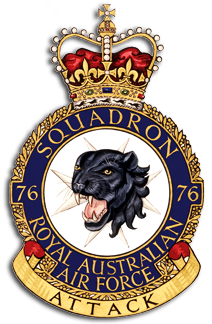
No. 76 Squadron is a Royal Australian Air Force (RAAF) flight training squadron. Established in 1942, it operated P-40 Kittyhawk fighter aircraft in the South West Pacific theatre during World War II. Following the end of hostilities it re-equipped with P-51 Mustangs and formed part of Australia's contribution to the occupation of Japan until disbanding in 1948. The squadron was re-formed in 1949 and three years later transferred to Malta, where it operated de Havilland Vampire jet fighters on garrison duty until again disbanding in 1955. It was reactivated in 1960 and operated CAC Sabre and Dassault Mirage III fighters in Australia until 1973. No. 76 Squadron was re-formed in its present incarnation in 1989 and is currently stationed at RAAF Base Williamtown, New South Wales, where it operates Hawk 127 jet training aircraft.

No. 79 Squadron is a Royal Australian Air Force (RAAF) flight training unit that has been formed on four occasions since 1943. The squadron was established in May 1943 as a fighter unit equipped with Supermarine Spitfires, and subsequently saw combat in the South West Pacific theatre of World War II. Between June 1943 and the end of the war in August 1945 it flew air defence patrols to protect Allied bases and ships, escorted Australian and United States aircraft, and attacked Japanese positions. The squadron was disbanded in November 1945, but was re-formed between 1962 and 1968 to operate CAC Sabres from Ubon Air Base in Thailand. In this role it contributed to the defence of Thailand against a feared attack from its neighbouring states and exercised with United States Air Force units. No. 79 Squadron was active again at RAAF Base Butterworth in Malaysia between 1986 and 1988 where it operated Mirage III fighters and a single DHC-4 Caribou transport during the period in which the RAAF's fighter squadrons were transitioning to new aircraft.

No. 452 Squadron is a Royal Australian Air Force (RAAF) air traffic control unit. It was established in 1941 as a fighter squadron, in accordance with Article XV of the Empire Air Training Scheme during World War II. The squadron flew Supermarine Spitfires for the entire war, initially over the United Kingdom and Nazi-occupied Europe. It was later based in Australia and the Netherlands East Indies, before being disbanded in 1945. It was re-raised in its current role in February 2011.

No. 457 Squadron was a Royal Australian Air Force (RAAF) fighter squadron of World War II. Equipped with Supermarine Spitfire fighters, it was formed in England during June 1941 under Article XV of the Empire Air Training Scheme. The squadron was transferred to Australia in June 1942 and saw combat in the South West Pacific Area before being disbanded in November 1945.

Wilfred Stanley Arthur, was a fighter ace and senior officer of the Royal Australian Air Force (RAAF) during World War II. Commonly known as "Woof", he was officially credited with ten aerial victories. As a commander, he led combat formations at squadron and wing level, becoming at twenty-four the youngest group captain in the history of the RAAF.
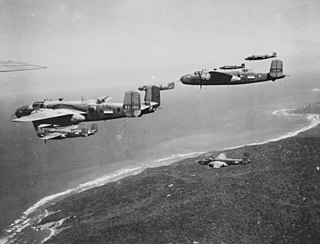
The North-Western Area Campaign was an air campaign fought between the Allied and Japanese air forces over northern Australia and the Netherlands East Indies (NEI) between 1942 and 1945. The campaign began with the Japanese bombing of Darwin on 19 February 1942 and continued until the end of the war.
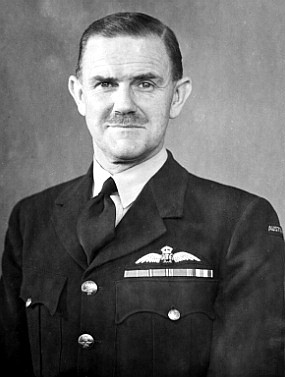
Air Vice-Marshal Francis Masson Bladin, was a senior commander in the Royal Australian Air Force (RAAF). Born in rural Victoria, he graduated from the Royal Military College, Duntroon, in 1920. Bladin transferred from the Army to the Air Force in 1923, and learned to fly at RAAF Point Cook, Victoria. He held training appointments before taking command of No. 1 Squadron in 1934. Quiet but authoritative, he was nicknamed "Dad" in tribute to the concern he displayed for the welfare of his personnel.

During March 1944, the Allies of World War II rapidly reinforced the military units located in the state of Western Australia to defend against the possibility that Japanese warships would attack the cities of Fremantle and Perth. This redeployment began on 8 March after concerns were raised about the purpose of Japanese warship movements near the Dutch East Indies, and ended on 20 March, after it was concluded that an attack was unlikely.
No. 1 Wing was an Australian Flying Corps (AFC) and Royal Australian Air Force (RAAF) wing active during World War I and World War II. The wing was established on 1 September 1917 as the 1st Training Wing and commanded the AFC's pilot training squadrons in England until April 1919, when it was disbanded. It was reformed on 7 October 1942 as a fighter unit comprising two Australian and one British flying squadrons equipped with Supermarine Spitfire aircraft, and a mobile fighter sector headquarters. The wing provided air defence to Darwin and several other key Allied bases in northern Australia until the end of the war, and was again disbanded in October 1945.

No. 80 Wing was a Royal Australian Air Force (RAAF) wing of World War II. The unit was formed on 15 May 1944 and eventually comprised three squadrons equipped with Spitfire fighter aircraft. The wing's headquarters was absorbed into the newly formed No. 11 Group on 30 July 1945.

No. 73 Wing was a Royal Australian Air Force (RAAF) wing of World War II. It was formed in February 1943 at Port Moresby, Papua New Guinea, as part of No. 9 Operational Group. The wing initially comprised three attack squadrons flying CAC Wirraways, Douglas Bostons, and Bristol Beaufighters, with which it took part in the New Guinea campaign until mid-year. It was then reorganised with three fighter squadrons operating P-40 Kittyhawks and Supermarine Spitfires; in this form it saw action in the New Britain and Admiralty Islands campaigns through 1943–44. The wing was disbanded at Los Negros in August 1944, and by the beginning of 1945 its squadrons had been absorbed into other RAAF wings under No. 10 Operational Group.
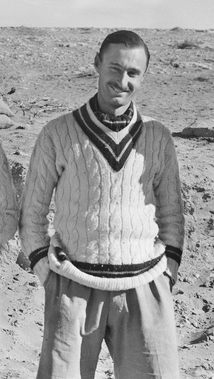
Air Commodore Gordon Henry Steege, was a senior officer and pilot in the Royal Australian Air Force (RAAF). He became a fighter ace in World War II, credited with eight aerial victories, and led combat formations at squadron and wing level.

Leslie Douglas (Les) Jackson, DFC & Bar was an Australian fighter ace of World War II, credited with five aerial victories. Born in Brisbane, he was a businessman when he joined the Royal Australian Air Force (RAAF) Reserve in 1937. Called up for active duty shortly after the outbreak of war in September 1939, he served with No. 23 Squadron in Australia before posting to the South West Pacific theatre with No. 21 Squadron in Singapore. In March 1942 he joined No. 75 Squadron in Port Moresby, New Guinea, flying P-40 Kittyhawks under the command of his eldest brother, John. During the ensuing Battle of Port Moresby, Les shot down four Japanese aircraft.

Peter Jeffrey, was a senior officer and fighter ace in the Royal Australian Air Force (RAAF). Born in Tenterfield, New South Wales, he joined the RAAF active reserve in 1934, and transferred to the Permanent Air Force (PAF) shortly before World War II. Posted to the Middle East in July 1940, Jeffrey saw action with No. 3 Squadron and took command of the unit the following year, earning the Distinguished Flying Cross for his energy and fighting skills. He was appointed wing leader of No. 234 Wing RAF in November 1941, and became an ace the same month with his fifth solo victory. The next month he was awarded the Distinguished Service Order for his achievements, which included rescuing a fellow pilot who had crash landed in the desert.

North-Western Area Command was one of several geographically based commands raised by the Royal Australian Air Force (RAAF) during World War II. Its wartime sphere of operations included the Northern Territory, adjacent portions of Queensland and Western Australia, and the Dutch East Indies. The command was formed in January 1942, following the outbreak of the Pacific War, from the western part of Northern Area Command, which had covered all of northern Australia and Papua. Headquartered at Darwin, North-Western Area Command was initially responsible for air defence, aerial reconnaissance and protection of the sea lanes within its boundaries.

Wing leader, or wing commander (flying), denotes the tactical commander of a Commonwealth military wing on flying operations. The terms refer to a position, not a rank, although the role was usually taken by an officer ranked wing commander. The position was also distinct from the commanding officer of the wing, generally a higher-ranked officer. The first wing leaders were appointed in 1941, and the position remained in use until the 1960s.

Alan Charles Rawlinson, was an Australian airman who became a fighter ace in World War II. He was credited with at least eight aerial victories, as well as two aircraft probably destroyed, and another eight damaged.
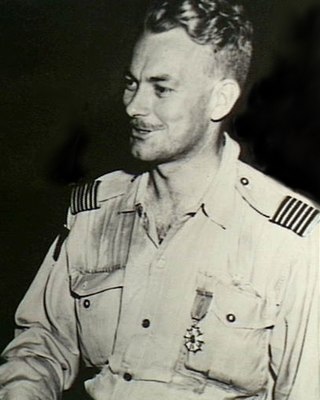
Louis Thomas Spence, DFC & Bar was a fighter pilot and squadron commander in the Royal Australian Air Force (RAAF). During World War II, he flew with No. 3 Squadron, earning the Distinguished Flying Cross (DFC), and commanded No. 452 Squadron, receiving a Mention in Despatches. He led No. 77 Squadron in the opening months of the Korean War, and was awarded a bar to his DFC, the US Legion of Merit, and the US Air Medal, for his leadership.



















